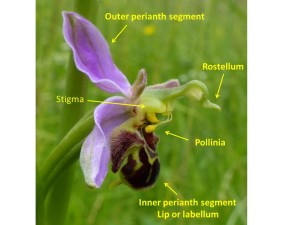The second largest flowering plant family in the World with about 18,500 species, and a family needing little introduction being surely the most popular and admired plant family in the World beloved of Orchid fanciers everywhere!
The Orchidaceae in brief:
- A monocot family, so leaves with parallel venation and floral parts in 3s
- In the tropics many species epiphytic on trees but all native British orchids terrestrial – growing on soil and perennial herbs with rhizomes or tuberous roots
- Flowers usually with bilateral symmetry in spikes or racemes, perianth in 2 whorls, the outer of 3 sepal more or less alike and coloured, the inner of 3 petals but with one very different to the others and forming a lip called a labellum
- Orchids are insect pollinated in Britain and the single anther forms two stalked or unstalked pollen masses the pollinia which have sticky bases and adhere to the heads of insects visiting the flowers so they are carried off and may pollinate other plants in this way, some species very specialised and fertilised by just one species of insect
- Insects are attracted by colour, scent, shape or nectar often secreted in the hollow spur developed at the rear of the labellum
- Seeds minute and dust-like and dispersed huge distances though usually requiring specialised fungi (mycorrhizae) in the soil for germination and growth of a new plant.
An example from the Orchidaceae: Ophrys apifera (The Bee Orchid)
A familiar and beautiful species with the labellum furry and bee-like, hence the specific name “apifera” from “apis” meaning bee. The leaves are grey-green and elliptical-oblong, pointed, in a basal rosette and also along the glabrous stem. The flowers are large (to 3 cm) and spaced out up the stem, the sepals are rosy pink and with green veins, the two upper petals are shorter and stocky, downy, greenish, the labellum is bee-like, brown and furry, convex and blunt tipped. The rostellum is large and shaped like a ducks head and the pollinia long stalked. Not an especially rare species and can be frequent in calcareous and damp grassland also colonising disturbed ground and quarries.


